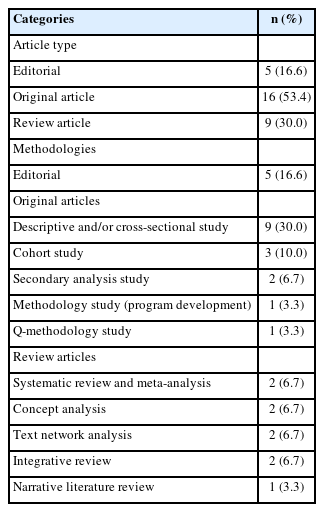Journal statistics in 2023 and catalysts for the future transformation of Child Health Nursing Research
Article information
Happy New Year to all the readers of Child Health Nursing Research (CHNR) around the world! My name is Yunsoo Kim, and I have the honor of serving as the Editor-in-Chief of CHNR for the 2024–2025 term. As we celebrate the 30th anniversary of CHNR, I am eager to build upon the successes of my predecessors and to further advance the journal. In this article, I will outline the current status of the journal and share our plans for its development in 2023.
Volume 29 of CHNR was published in 2023, comprising four issues with a total of 30 articles in English. The average number of authors per article was 2.61 (standard deviation, 1.85; range, 2–8) (Table 1). Notably, 92.7% of the authors were Korean, with the remaining 7.3% hailing from Indonesia, Jordan, and Ghana. The proportion of foreign authors decreased by 8.4% from the previous year. In 2023, 60.0% of the articles were funded by national organizations, universities, or public institutions.
The distribution of article types remained consistent with that of 2022, with five editorials (16.6%), 16 original articles (53.4%), and nine review articles (30.0%) (Table 2). Descriptive and cross-sectional studies were the most common type of original articles, accounting for 30.0% of the total, followed by cohort studies at 10.0%, secondary analysis studies at 6.7%, and methodology studies (program development) and Q-methodology studies at 3.3% each. Although the total number of original articles remained the same as in 2022, the variety of article types increased. In 2023, CHNR published a diverse range of articles, including systematic and meta-analyses, concept analyses, text network analyses, integrative reviews, and a narrative literature review.

Research Subjects, Article Types, and Methodologies of Publications in Child Health Nursing Research in 2023 (N=30)
Although the total number of articles published was the same as in 2022, this expansion in article types demonstrates our commitment to providing comprehensive coverage of the field. While we continue to face challenges in terms of author diversity and article volume, we remain confident in our ability to deliver high-quality content to our readers. CHNR will continue to publish high-quality articles on children’s health written by authors from countries throughout the globe.
CHNR is indexed in the Cumulative Index to Nursing and Allied Health Literature (CINAHL), Scopus, Directory of Open Access Journals (DOAJ), Google Scholar, Crossref, Korea Citation Index (KCI), KoreaMed, and Korean Medical Citation Index (KOMCI), which maintain records of all publications published in CHNR. The DOAJ and Scopus Content Selection and Advisory Boards both approved CHNR for inclusion in their databases in July 2019 and February 2018, respectively. Additionally, the National Research Foundation of Korea (NRF) updated its assessment of CHNR in 2020, and it is now part of the KCI. Immediately upon publication, all manuscripts published in CHNR are indefinitely accessible to the public, with open access for anybody to read and download from the CHNR website (http://www.e-chnr.org/). CHNR was indexed in PubMed Central (PMC) in December 2021, and it is available in PMC from the January 2019 issue (Vol. 26, issue 1) onward. The members of the CHNR journal editorial board are actively working to have the journal included in MEDLINE and Emerging Sources Citation Index (ESCI), as well as PMC.
CHNR’s aim is to promote the health, development, and well-being of children and their families in Korea and worldwide. We encourage submissions on recent and relevant healthcare and nursing topics for children from early childhood to young adulthood, including those from diverse countries and cultures.
All parties involved, including the editorial board members, peer reviewers, and authors, must make a concerted effort to maintain a high standard of quality at CHNR. The peer reviewers and editors strive to improve the quality of articles submitted by authors. CHNR expects strict adherence to reporting guidelines (https://www.equator-network.org/) in accordance with the research methodology. Authors submitting to CHNR are required to follow the reporting guidelines that correspond to their research methodology.
As we approach our 30th anniversary in 2024, we remain committed to maintaining the highest standards of research and publication. CHNR has made significant progress since its inception, thanks to the efforts of many people. I express my sincere gratitude to the authors for submitting their articles to CHNR, the reviewers for their valuable feedback, and the members of the editorial board for their diligent efforts in improving the quality of the journal. I also extend my thanks to the past officers of the Korean Society of Child Nursing for their unwavering support in improving the quality of CHNR. Your efforts and dedication will establish CHNR as a landmark in the field of child nursing.
Notes
Authors' contribution
All the work was done by Yunsoo Kim.
Conflict of interest
Yunsoo Kim has been the editor-in-chief of Child Health Nursing Research since 2022. She was not involved in the review process of this editorial. No existing or potential conflict of interest relevant to this article was reported.
Funding
None.
Data availability
Please contact the corresponding author for data availability.
Acknowledgements
None.


